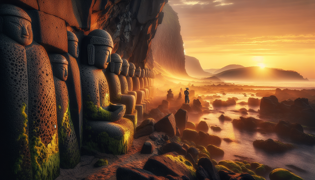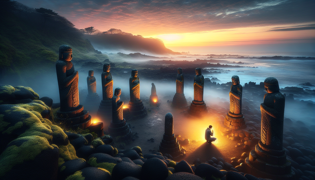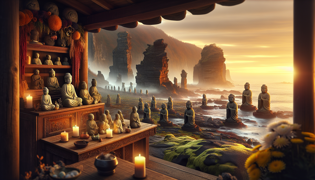Introduction
Beneath the bruise-purple sky of Jeju Island, the Dolhareubang stand clustered like ancient watchers carved by a volcanic heartbeat. Their cracked features rise from black basalt, cold yet somehow alive beneath a salt breeze that tastes of endless ocean and sunburnt memories. Each stone grandfather wears a smile as steady as an old oak in winter, and a gaze that reaches deeper than a hidden spring. Travelers say the rough surface feels like the skin of aged leather, and when fingertips trace moss-damp grooves, you can almost hear the earth exhale. In the hush before dawn, seagulls wheel overhead, their cries threading through the jagged silhouette of the guardians. A whisper rides on that wind—거시기허멍, the locals murmur—meaning life unfolds in its own rhythm. Hidden between volcanic stones, the idiom 무르팍 reminds every pilgrim to stay within arm’s reach of truth. Salt crystals cling to lips like sugar in a baker’s bowl, and the air carries the faint hum of submerged memories. Like a lighthouse of memory, the Dolhareubang beckon wanderers toward a path paved in ancient wisdom, urging them to listen to stories carved into granite hearts and to honor the silent strength that outlasts storms.
Origins of the Dolhareubang
In centuries long past, Jeju Island was a landscape still settling from fiery upheaval. Volcanoes exhaled rivers of molten stone, which froze under the watchful sun, painting the land in deep charcoal hues. It was here, amid blackened fields and emerald moss, that the first Dolhareubang emerged. Local sculptors, inspired by both Buddhist deities and ancestral guardians, hollowed each figure from oversized basalt boulders, using crude chisels made of hardened rock. Their faces were broad and benign, with lips curled into knowing smiles. Legends swirl that each stone figure was infused with a fraction of island spirit, making them watchers of both land and sea. The youngest villagers spoke of shadows that danced between the statues at twilight. Each Dolhareubang was said to absorb sorrow carried by fishermen returning from distant seas, then exhale calm in moments of storm. When salt spray drenched their shoulders, moss spread like emerald lace across cracked brows, reminding passerby that even stone can become a living tapestry of nature. Poems and songs etched in local tongues spoke of their steadfast gaze, as unwavering as the northern star. Through “숨비소리,” the breath-like sighs of diving haenyeo weaving through undercurrents, the guardians learned human longing and heartbreak, then translated that knowledge into silent fortitude. The genesis of these grandfathers is entwined with myth and memory—fire meeting water, earth embracing sky—to form sentinels for generations unborn.
With each sunrise, temple bells on distant hills would puncture the ocean’s hum, guiding monks along winding paths to pay their respects. Pilgrims whispered oaths of protection for their families as they circled the carvings three times, stroking downturned lips and bald caps. The wind, cold and briny, carried voices of ancestors who once plowed fields and cast nets along the shore. Through every beating storm, these stone figures weathered lightning’s kiss and tidal fury, emerging unchanged yet indelibly marked. Visitors spoke of feeling the weight of countless prayers in the press of stone against skin—an embrace both gentle and unyielding. In Jeju dialect, they’d say “거시기허멍 오래 간다,” meaning good things endure in silence. And so the Dolhareubang endured, as silent as the moon yet as powerful as a rising tide.

The Whispering Winds and Hidden Trials
Legends say that only those pure of heart can hear the Dolhareubang speak. They murmur through the wind—voices like water trickling between mossy cracks. It is said nobody understands the language except those who have faced their deepest fears. One evening, a young girl named Bomi arrived at the field of statues with sand in her sandals and longing in her eyes. She had sailed two nights across restless waves, guided by a single lantern beam. As she approached, salt-laden gusts whistled about her ears like unseen flutes, and the stones leaned inward, as if to inspect her soul. Bomi placed her palm on the nearest figure’s flanks, feeling micro-grain edges prick her skin. The basalt was cool, almost liquid in its smoothness, and beneath, a faint thrum of ancient memory pulsed.
Night fell like ink, speckled with stars. Bomi closed her eyes, and in the hush heard a voice, deep as an ocean trench: “Are you willing to carry our weight until the wind sets you free?” It was a challenge wrapped in a question. With a trembling nod, Bomi agreed, knowing that every step forward would be measured against her courage. The wind roared approval or dismay—sometimes both—and sometimes fell into uneasy silence. For three trials she would resist fear’s clutch. The first summoned visions of home, urging her to flee. The second unleashed memories she’d locked away—a father’s gruff laughter, a mother’s lullaby drowned by tides. The third tested her resolve by offering her deepest desire in exchange for silence. Each trial felt like standing on a precipice of glass, shards drifting beneath bare feet. When dawn tinted the sky pink, only a heartbeat remained of Bomi’s fear. But the stones had given her strength drawn from earth’s core, as if her blood now flowed through hidden veins of basalt.

Legacies Etched in Stone
When Bomi emerged at sunrise, her eyes glimmered like polished onyx. The Dolhareubang gathered dawn’s first rays upon their stone crowns and seemed to bow in solemn respect. Word spread across Jeju like ripples from a pebble dropped in clear water: a traveler had passed through the trial. People flocked to the field, leaving hairpins, seashells, and etched wooden amulets at the statues’ feet. Some claimed the protective aura radiating from the stones cured ailments or guided runaway calves back to their herds. Others said that children who whispered secrets to the round-bellied figures awoke with newfound courage. Over centuries, the Dolhareubang inspired haenyeo to dive deeper and farmers to sow seeds in barren soil, embodying island resolve and adaptability.
Carpenters and painters began replicating their forms in household shrines, carving miniature guardians for each doorframe. On festival days, villagers draped garlands of bright chrysanthemums around the tall ones that stood by coastal temples. Drums echoed in the night air, and dancers wearing masks sculpted in granite shapes moved in a silent chorus, paying homage to the grandfathers of stone. The carvings evolved—some wearing wreaths of spring blossoms, others donning red silk scarves gifted by lovers who sought protection on long voyages. Across fields and courtyards, the silhouettes of Dolhareubang multiplied like whispered prayers made manifest.

Even today, travelers trekking the Olle Trail pause before each variation, placing hands upon weathered cheeks. They murmur the idiom 거시기허멍 when dawn mist hovers, pledging to carry small blessings onward. As volcanic rock weathers into curious shapes, the islands’ guardians remind all who wander that true strength grows in silence, like roots expanding beneath hard stone. Every etched wrinkle embodies a story, every chipped nose a lesson in perseverance, and every broad smile a beacon of hope—proof that carved from hardship, one can stand unmoving while still touching countless lives.
Conclusion
As the sun dips below the horizon, the Dolhareubang silhouette merges with the crimson sky, standing guard over ancient coves and hidden villages. Their stone eyes hold stories older than any surviving manuscript, and their silent whispers flow through the air like a forgotten melody rediscovered at dusk. Pilgrims and poets, fishermen and farmers—each finds a reflection of their own courage etched into the gray faces of these grandfathers. The wind that once tested Bomi now carries her laughter across the island, a testament to trials faced and overcome. When visitors trace their fingers along rugged basalt, they feel a pulse of something enduring; a promise that wisdom carved in stone will outlast fleeting seasons. These guardians—steady as the tides—remind us that inner strength is forged through patience, faith, and the willingness to stand firm when storms assail us. On Jeju’s rugged plains, beneath skies that shift from rose to indigo, the Dolhareubang remain beacons of quiet resilience, inviting every wandering soul to find shelter in their enduring gaze and to carry island wisdom wherever paths may lead.


















